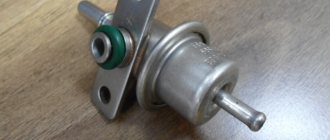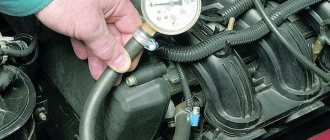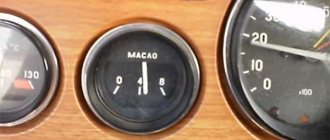Modern cars with internal combustion engines use a closed liquid cooling system. In most cases, antifreeze circulates inside the system. Although some stubbornly continue to pour ordinary water into it, which is a gross violation of the operating rules.
A constant excess pressure is created inside this system while the engine is running. Not everyone understands why this is necessary, since the main task is to ensure efficient circulation of the cooling fluid in small and large circles.
In fact, pressure plays a big role in the operation of the internal combustion engine. It allowed us to get rid of a common and very pressing problem with old cars.
Why is internal pressure created?
Having dealt with the pressure in the engine cooling system, much will become clear and obvious.
There is an example of old cars. In them, the liquid continuously circulated in the motor, heated up, taking away excess heat, and then cooled in the radiator due to the counter flow of air and air from a forced fan.
Then ordinary water was poured into the radiator, and the car drove smoothly. But it often happened that the driver was forced to stop in the middle of the road, because thick white steam began to pour out from under the hood. The engine simply began to boil, and the water began to boil and actively evaporate. This is what provoked the appearance of thick white smoke (steam).
To continue the journey, I had to cool the internal combustion engine, fill in new cold water and drive off. At that time, the concept of engine boiling was familiar to almost every car owner.
You will soon understand why the cooling system of a modern engine requires pressure. The reason for boiling of old internal combustion engines is extremely simple. Water under normal conditions at normal atmospheric pressure boils when the temperature reaches 100 degrees Celsius. Circulating in a circle, with a heavy load on the motor, the water does not have time to cool down, and therefore boils.
In modern antifreezes poured into cars, the boiling point has increased to 105-115 degrees Celsius.
Now remember your school physics course, and it will immediately become clear why you really need to create pressure in the cooling system. As the pressure increases, the boiling point of the corresponding liquid also increases.
As the pressure inside the system increases, the antifreeze will boil at a correspondingly higher temperature.
This significantly protects the motors from the boiling effect. Most engines under normal conditions heat up to a temperature of 90-95 degrees Celsius during operation. Using ordinary water and without pressure inside the system, literally with a slight overload the motor would boil. And since antifreeze is poured in, plus the boiling point has increased due to the pressure created, the boiling threshold is pushed back to about 110-120 degrees Celsius. This allows you to eliminate the occurrence of problems even under heavy loads on the internal combustion engine.
And in order to create the required level of pressure in the system itself, there was no need to develop any special technologies. For this purpose, closed cooling systems are used. The liquid in them gradually heats up as the engine operates, steam is formed, and it creates the same pressure.
Pressure cannot increase indefinitely, but it also cannot fall below a certain level. To control these parameters, valve covers are used on the radiator and expansion tank.
The cap allows you to release or build up pressure as needed. This is a compact, but very useful and important device that works for the benefit of the cooling system and the entire engine.
Engine cooling system pressure: what you need to know
The question regarding the pressure in the engine cooling system is quite common, since problems with this system or malfunctions in the operation of its individual components often lead to engine overheating, rupture of pipes, hoses, radiator, expansion tank, etc.
In simple words, you can often hear from car enthusiasts that a hose or tank burst due to high pressure. In this article we will look at how the engine cooling system works, where the pressure comes from and why it is formed.
What is the pressure in the engine cooling system
So, internal combustion engines are a heat engine, that is, the energy of fuel combustion is converted into mechanical work. At the same time, the efficiency of engines of this type (especially gasoline) is quite low, since useful energy is largely spent on heating and friction of associated parts.
When it comes to heating, the engine needs efficient cooling. If parts overheat, the gaps between them decrease as a result of thermal expansion. In the case when the power unit is very overheated, the motor simply jams.
To remove excess heat, modern internal combustion engines use a combined cooling system, which consists of air and liquid systems. The liquid system implements the circulation of a special coolant (antifreeze, antifreeze) through channels in the block and cylinder head.
The air system should be understood as a cooling system fan, which turns on at a certain temperature and cools the engine by blowing it with air flow. As for the liquid system, the coolant circulates in this system under a certain pressure.
It is noteworthy that the pressure inside the cooling system is not created intentionally (forced), but is the result of the operating features of this system. By the way, to maintain a normal temperature balance for the engine, it is not the pressure that is important, but the normal circulation of coolant through the system.
So, the coolant in the system heats up. Heating causes expansion and the liquid level in the system rises. Taking into account the fact that the liquid system is closed, it is not difficult to guess that as the internal combustion engine and the liquid itself heat up, the antifreeze/antifreeze expands greatly and increases in volume (up to 20%). As a result, pressure builds up inside.
Moreover, the tightness and pressure in the system allows the boiling point of the coolant to increase. In simple words, if at atmospheric pressure coolant or water boils at 100 degrees Celsius, then, taking into account the increased pressure, the boiling point shifts upward.
For example, a pressure of 1.5 atmospheres means that the coolant will boil at 110 degrees, increasing the pressure by another 0.5 atm. will push the boiling point back another 10 degrees, etc. If we add that in modern antifreezes the additive package also makes it possible to improve the properties of the liquid itself, the boiling point is often around 130-140 degrees at the required pressure. This allows you to increase the temperature at which the thermostat operates, making the engines hotter, more productive and at the same time environmentally friendly.
Let's move on. On different engines, the operating pressure inside the cooling system may differ from 1.2 to 2.0 atm. or even more (in other words, from 1.2 to 2.0 Bar). This indicator depends on the design features of the internal combustion engine, the properties of the coolant itself, temperature control, etc. In this case, the pressure is created by the liquid itself when heated in a closed circuit.
In this case, excess pressure is released into the atmosphere by a special valve located in the cap of the expansion tank. Please note, it is important to understand that the performance and efficiency of engine cooling directly depends on this valve and the overall tightness of the system itself.
In simple words, if the system is sealed, the valve controls the pressure inside the system, preventing the formation of excess pressure, which prevents the rupture of pipes, the radiator or the expansion tank itself, etc.
Another function of the reservoir cap is to equalize pressure after the engine is turned off and the coolant begins to cool. The level of cooling coolant decreases; during cooling, a vacuum inevitably forms in a closed system. It is quite obvious that this will also lead to problems. To equalize the pressure, the valve in the expansion tank cap opens and outside air is drawn in through it.
Tips and tricks
So, if during the operation of the vehicle it was noticed that antifreeze is being squeezed out in some place, a common cause is excess pressure in the engine cooling system. Moreover, if there is no obvious antifreeze leak, then the diagnosis must begin with the expansion tank cap.
Especially often, problems with the lid manifest themselves in such a way that antifreeze or antifreeze is squeezed out from under the lid itself (both during operation of a hot internal combustion engine and after the power plant has cooled down). Another common situation is when, as a result of a pressure failure in the system, some pipes or hoses break.
Finally, we note that air leaks in the cooling system, as well as the ingress of gases from the combustion chamber into the expansion tank, are quite common malfunctions that also impair the performance of the liquid cooling system and often cause a decrease in the coolant level and engine overheating.
As a rule, the seal is broken due to insufficiently tightened clamps on the pipes, cracks in hoses and pipes, etc. lead to the fact that the operating pressure in the cooling system decreases and the antifreeze begins to boil. This is often accompanied by bubbling in the expansion tank.
If gases from the cylinders enter the system, a critical increase in pressure often occurs, as a result of which antifreeze or antifreeze presses, the pipes or radiator can simply rupture. In this case, a common cause is a broken cylinder head gasket, cracks in the block itself or the cylinder head.
Source: https://krutimotor.ru/davlenie-v-sisteme-ohlazhdeniya-dvigatelya/
Normal parameters
It is difficult to say unambiguously what pressure should be in the cooling system of each car. Even on the same model with different installed internal combustion engines, the parameters may differ.
If we talk about average values, then this range is from 1.2 to 2 atmospheres. Although it is extremely rare that the indicators reach 2 atmospheres. But in the automotive industry there is an example when a pressure of 2.2 is considered the norm.
When calculating fluid pressure, the unit of measurement is usually Bars. But they are analogous to atmospheres. That is, 1 atm = 1 bar.
The internal pressure in an automobile cooling system depends on a number of factors. And not the least important role is played by what kind of coolant is poured into the radiator, what design the car’s engine has, its tightness and other nuances.
You can find out accurate information regarding the pressure level specifically in your engine from the manual and operating recommendations from the car manufacturer.
How is pressure created inside?
Now, probably, many people think that the pressure inside the cooling system is created on purpose! This is partly true, but partly not! Actually, the engine doesn’t give a damn, the main thing is that it is cooled. And no one is going to deliberately force it there. Everything happens by itself. BUT HOW?
This is a fairly easy physical process; any coolant (antifreeze or antifreeze), and even distilled water , expands when heated. That is, its level is growing, and antifreezes are expanding especially strongly - FROM 10 TO 20% in volume.
But the cooling system is a closed, sealed circuit, that is, it has virtually no contact with the environment at all.
Well, now imagine - a cold engine, you just added new fluid to the system, let’s say “to the level”, the pressure in it is almost “zero”. Close the expansion tank cap and start the engine. The system begins to warm up, the antifreeze expands and, accordingly, begins to put pressure on the walls of the radiators, pipes, etc. thus, it is created internally.
How is blood pressure checked?
Quite often, motorists are interested in how to check the current pressure in the cooling system in a garage. This is not so easy to do.
For such tasks, special stands are usually used in a car service center, and complex diagnostics are carried out in different operating modes. Approximate indicators can be determined by connecting a pressure gauge to a sealed system. But such manipulations should not be carried out in a garage and without specialized equipment.
Typically, a self-check involves diagnosing the valve cover of the expansion tank. It needs to be checked for integrity, make sure there are no cracks or damage, examine the condition of the seals, etc.
There is also an alternative verification option. To do this, you will need a pressure gauge, pump or compressor. The upper pipe is removed from the expansion tank, and a hose connected to the pump is connected in its place. Pressure is created. When the peak value is reached (usually about 1.4-1.5 atm), the valve should operate.
What should normal blood pressure be?
The pressure in a car's engine cooling system cannot be increased indefinitely, since too high will eventually lead to rupture of its weakest elements. Normally it should be 1.2–1.4 atm. As the antifreeze heats up and reaches its boiling point, the pressure reaches a critical value. At this moment it must be reset in order to avoid failure of the cooling system first, and then jamming of the pistons in the cylinders, and as a result, breakdown of the latter.
To maintain pressure within acceptable limits, an air valve is installed in the cap of the expansion tank (for VAZ-2110) or radiator.
It has a simple device:
- inside the case, which has identical holes at the top and bottom, there is a ball slightly larger than the holes.
- The weight of the ball is selected in such a way that when a pressure reaches 1.5 atm, it rises, opening the lower hole and releasing air from the cooling system into the atmosphere.
- At the same time, while the coolant is not heated, the ball closes the lower hole, and the upper one remains open, providing an influx of atmospheric air and ensuring faster heating of the antifreeze.
The performance of the valve must be checked periodically, especially on older cars. The check is very simple: just shake the cap of the expansion tank or radiator and listen. If the ball rattles, the valve is working.
Nowadays, the most common version of the lid is one that has two valves (inlet and outlet). As the pressure rises, the release valve opens and the excess is discharged from the system. When it falls below atmospheric pressure, the intake begins to work.
Often, due to malfunction of the valves, the system ceases to function correctly. Moreover, even a new cover does not guarantee that everything will work as expected. Car owners often complain that the expansion tank bursts. This can be caused either by improper operation of the lid valves or by a defect in the tank itself (thin walls).
The actuation moment of the valves directly depends on the stiffness of the springs, so craftsmen regulate the actuation time by cutting off excess turns from it.
Periodic checks should not be neglected, since at the most inopportune moment the valve may jam either open or closed. In the first case, the cooling system will lose its tightness, as a result, the boiling point of the antifreeze will drop significantly, and the engine will simply “boil” in the middle of the road.
In this case, vapor-air plugs may form in the system, preventing the normal circulation of antifreeze, and this can cause local overheating of the engine and deformation of its various elements. In the second case, too much pressure is created in the closed system, which can lead to damage.
The role of the valve cover
Not everyone understands how important a role is played by a seemingly ordinary cap that closes the expansion tank for filling the coolant.
In fact, it is a complex device. Modern lids are equipped with two valves at once. These are exhaust (steam) and inlet. They are also called bypass and atmospheric, respectively.
In fact, this is a special valve that is responsible for the pressure inside the system in question. As the internal temperature rises as the engine heats up, the pressure also rises. If at some point the excess is not dumped, then the seal will be at risk. Elements can simply tear apart from the inside. Usually it all starts with damage to the most vulnerable elements in the form of seals and seals. A rupture of the expansion tank itself, hoses and pipes cannot be ruled out.
The valve cover directly on the expansion tank helps to remove excess pressure and pump it in as needed.
Each valve has a certain response threshold. Its mechanism is designed in such a way that when a certain value is reached, it opens or closes. This relieves excess pressure or sucks in atmospheric air.
When parked for a long time, the engine cools down, the liquid cools, which causes a rarefied atmosphere to form inside. This indicates insufficient pressure inside. To compensate, the valve cover opens and air is sucked in. Thus, the pressure is normalized.
How to detect leaks
You can start with a visual inspection of the elements of the cooling system, however, if the leak is not severe, the inspection is unlikely to yield results. The most reliable way to identify a weak point is to create increased pressure and watch where the antifreeze comes from. To avoid burns, the car engine must be cold.
In garage conditions, this will require a pump with a pressure gauge or a compressor. From the expansion tank you need to disconnect the pipe coming to it from above and connect the pump hose instead. The disconnected pipe must be plugged with a bolt of suitable diameter and the bolt must be secured with a clamp. After this, you can build up pressure and see where the leak appears. By the way, when the 1.5 atm mark is reached, the air valve should operate.
Let's say there are no obvious coolant leaks, which means you should check the floor in the cabin; antifreeze may be escaping through a leaky heater radiator. If there are also no traces of coolant in the cabin, all that remains is to inspect the cylinder block and, last of all, the inside of the cylinders, having first removed the spark plugs. It would also be a good idea to check the engine oil level: with internal leaks, it increases as antifreeze enters the engine crankcase. » alt=»»>
It is no secret that when the engine is running, excess pressure is created in the cooling system. In the BMW E39, the cooling system, when functioning normally, has an operating pressure of up to 2.0 bar, which is almost 2 atmospheres. 1 bar = 0.98 atmospheres. Not a little, right?
Let's start in order: Why do you think pressure is created in the cooling system?
Okay, okay, I won’t bother you and force you to search :P.
Pressure in the cooling system is created as an additional measure to prevent the liquid from boiling in the cooling system.
The fact is that everyone knows water boils at 100 degrees Celsius. But not everyone already knows that water can greatly change its boiling point.
For example, at the top of Everest, water will already boil at 69 degrees like this











